The tuna is a saltwater fish that is a member of the Scombridae (mackerel family) subfamily’s tribe Thunnini. Their scientific name, Thunnini, is derived from the Greek word which means “tunny fish.” Apart from opah and mackerel sharks, tunas are the only fish that can keep their body temperature higher than the temperature of the surrounding water. Tunas are also warm-water fish, are widely fished for commercial purposes, and are well-liked as bluewater game fish. Some tuna species, like the southern bluefin tuna, are in danger of extinction due to overfishing.
The tuna fish is a migratory species that has no established home range, and some species travel thousands of miles per year. For their small size, these fish are actually very fast and can move as fast as 40mph. These fish are relatively big, and although most species do not grow larger than 500 pounds, the bluefin tuna can grow as large as 1500 pounds. It is interesting to imagine what their teeth look like. Keep reading to discover facts about their teeth, how many they have, and what they use them for.
How To Identify Tuna
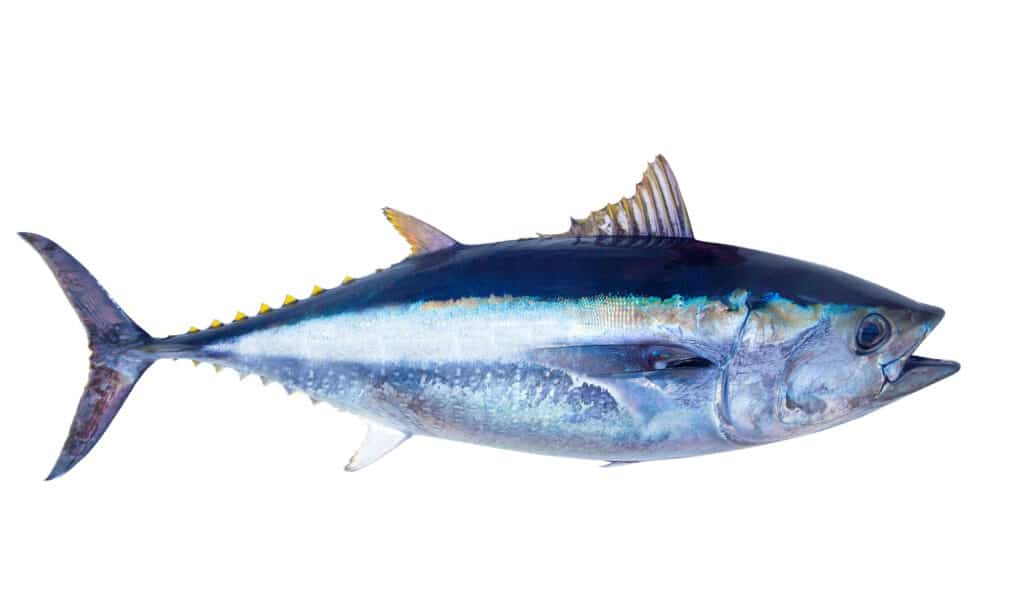
Tuna have long, torpedo-shaped body that tapers to a forked or crescent-shaped tail.
©lunamarina/Shutterstock.com
The tuna is a sleek and streamlined fish adapted for speed. The fish has a long, torpedo-shaped body that tapers to a forked or crescent-shaped tail. Only a few areas of the body are covered with scales; the majority of the body is covered in smooth, sparkling blue or silver metallic skin.
On its back, the tuna has two sparsely spaced dorsal fins. The ventral side, or underside, is typically silvery or pale for camouflage, whereas the dorsal side is typically a metallic dark blue. These fish prefer temperate and tropical seas of the Atlantic, Pacific, and Indian Oceans. They are also found in the pelagic zone, which includes all open ocean areas other than the coast and the bottom layer.
What Types of Teeth Do Tuna Have?
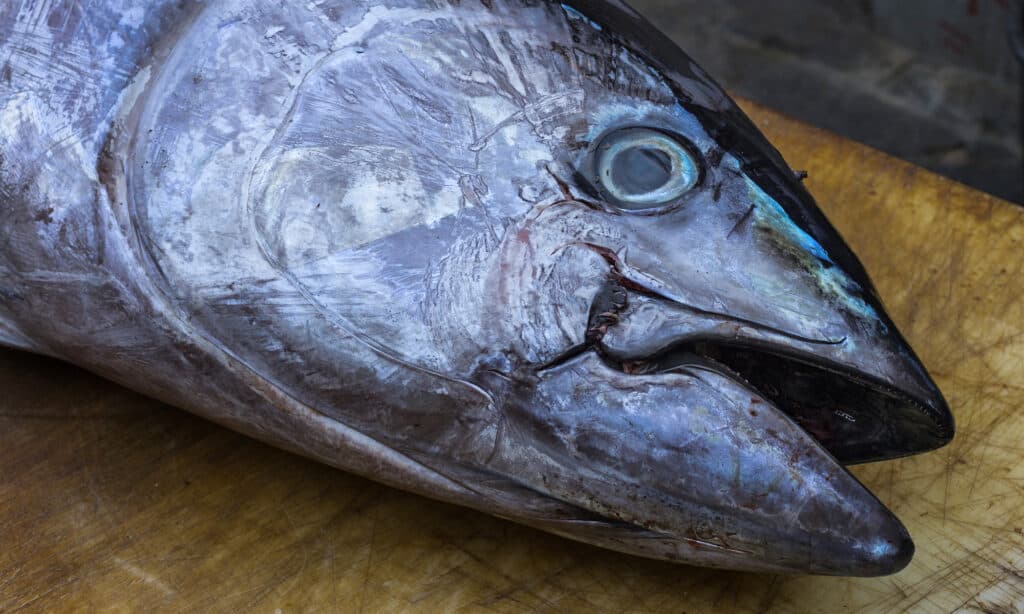
Yellowfin tuna have conical teeth.
©Angel DiBilio/Shutterstock.com
Atlantic bluefin tuna have rows of upper and lower needle-like sharp teeth. Yellowfin tuna, on the other hand, have more conical teeth. The dentition of most animals, including fish, depends on their dietary choices, and tuna are no different. Fish, squid, and shellfish are what tuna eat the most. If they’re the kind of tuna that hangs out on the ocean’s surface, squid makes up their primary food. Tuna that spend most of their time in deep seas typically eat fish and cephalopods.
Are Tuna Fish Born With Teeth?
Like other fish, baby tuna, also called fry, have teeth at the point where they are able to feed themselves. These baby fish, however, do not start eating until after their second day of being born. They feed mostly on algae and zooplankton. Over the next two weeks, their digestive systems grow, including their teeth, and by the end of their third week, these baby tuna can start eating like the adults.
How Many Teeth Do Tuna Have?
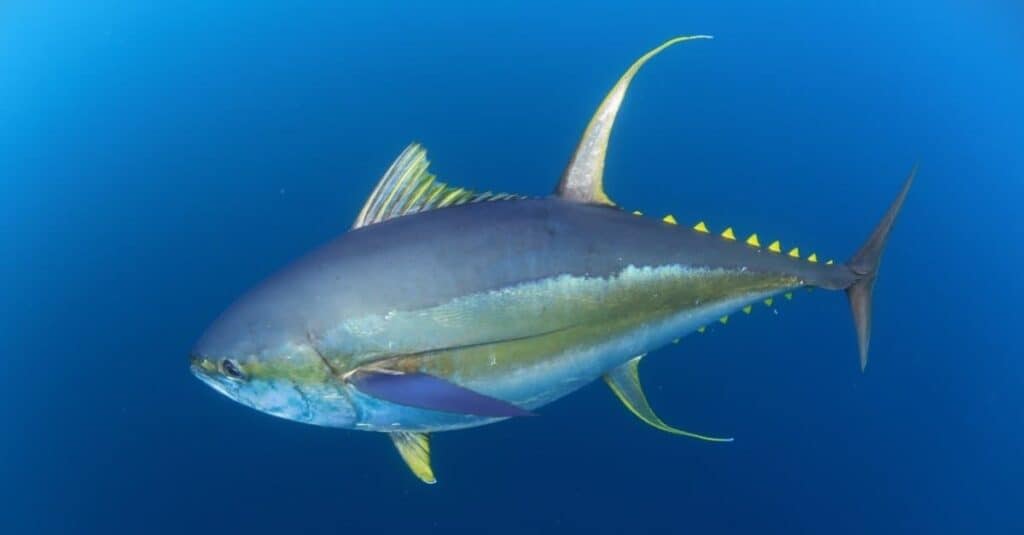
Tuna have 40 teeth.
©Al McGlashan/Shutterstock.com
Generally, tuna fish are carnivorous and have 40 teeth, 20 on each row. Fish have evolved to have several types of teeth depending on their diets, just like other animals. For instance, most carnivorous fish have teeth that are made to pierce, grasp, and cut their prey, but most herbivorous fish have teeth that are better suited to shredding things like algae. Tuna fish is covered in shimmering silver-blue scales, sickle-shaped fins, a row of ominous-looking yellow spines along the length of its back, and rows of pointed teeth.
Atlantic Bluefin Tuna Teeth
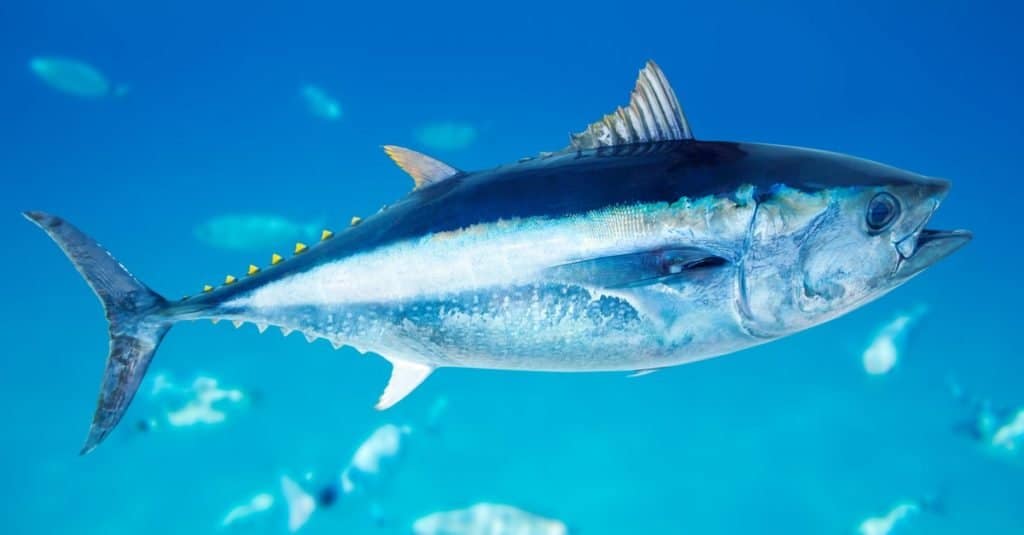
Atlantic bluefin tuna are the largest member of the tuna family.
©lunamarina/Shutterstock.com
The typical length and weight of the Atlantic bluefin tuna are quite substantial considering that it is the largest member of the tuna family. Fish that are fully grown often range in length from 5 to 8 feet and weigh between 400 and 600 pounds. The upper and lower jawlines of the bluefin are lined with rows of razor-sharp teeth. These teeth resemble needles and are quite small in relation to the fish’s body size. Due to their razor-sharp teeth, swift movements, and constant need for food, Atlantic bluefin tuna are always looking for prey. These fish eat a lot of squids, shellfish, and bony fish.
Yellowfin Tuna Teeth
Dark blue on the back and yellow sides that turn silver around the belly define the yellowfin tuna fish, also known as Ahi. The two protruding long, yellow fins on the back and stomach are also some of the most distinguishing features of this tuna species. Most specimens weigh up to 450 pounds. Because they are not as big as bluefin tuna, their teeth are not as big. These fish have really small teeth that are conical. They tend to feed on smaller fish, cephalopods, and crustaceans. Yellowfin are apparently sight-oriented predators as their feeding tends to take place in surface waters during the day.
Dogtooth Tuna Teeth
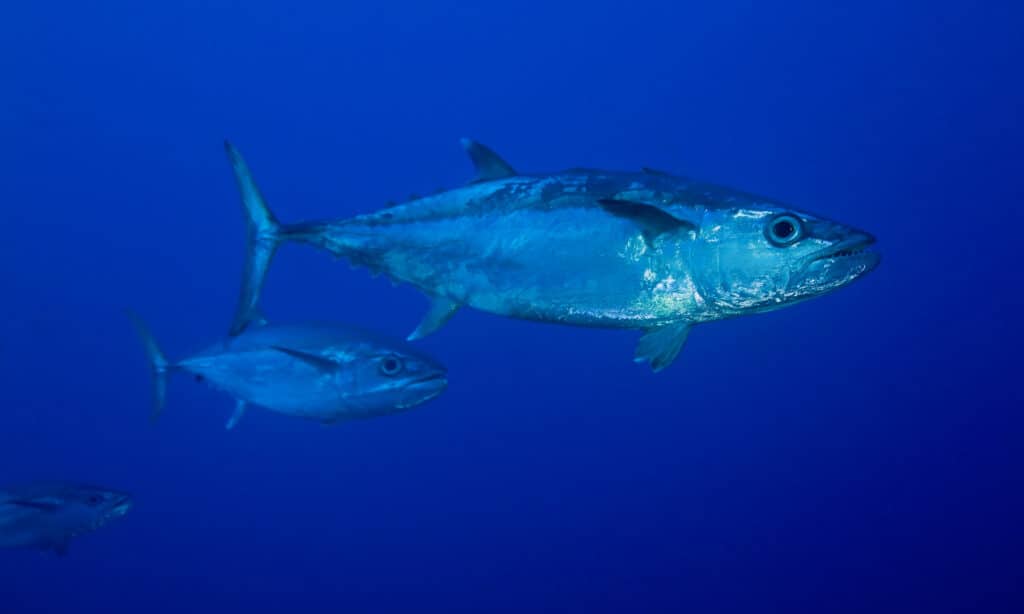
The dogfish tuna lacks scales and has counter-shaded skin.
©iStock.com/Yann-HUBERT
As their name implies, these species have teeth as sharp as a dog’s. Like other species of tuna, dogtooth tuna have 40 teeth. Their bodies are sleek and torpedo-shaped, with a huge head and mouth at the end where their canine teeth are located. There are 20 of these teeth per jaw. Dogtooth tuna fish are mostly pelagic fish. Because they migrate often, they seek water that is between 70 and 80 degrees Fahrenheit for their habitat. The shoaling species they feed on, including herring, sprats, mackerel, whiting, cuttlefish, and squid, prefer this water temperature as well.
Gymnosarda unicolor, popularly known as dogtooth tuna or white tuna, are commercially significant fish that may be found in the Indian and Pacific Oceans and are a crucial component of the food chain. This species lacks scales and has counter-shaded skin, which means the back is darker and the belly is lighter. The back of this species typically has a dark blue or blue-green hue, the sides a shimmering silver, and the belly white. A fully developed adult will typically weigh roughly 40 pounds and measure about five feet in length.
Up Next:
Ahi Tuna vs Yellowfin Tuna: What are the Differences?
Ahi Tuna vs Bluefin Tuna: Key Differences Explained
What Do Tuna Eat? Their Diet Explained
The photo featured at the top of this post is © iStock.com/Whitepointer
Sources
- Very Meaty, Available here: https://verymeaty.com/fresh-meat/fish/do-tuna-fish-have-teeth/
- Sweetish Hill, Available here: https://sweetishhill.com/how-many-teeth-do-tuna-fish-have/
- Very Meaty, Available here: https://verymeaty.com/fresh-meat/fish/tuna/do-bluefin-tuna-have-teeth/
Thank you for reading! Have some feedback for us? Contact the AZ Animals editorial team.






